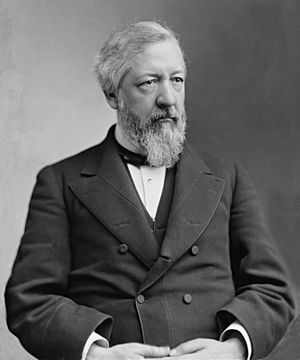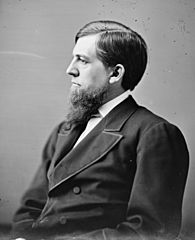Blaine faction facts for kids
Quick facts for kids
Blaine faction
|
|
|---|---|
| Leader | James G. Blaine William P. Frye Eugene Hale William H. Robertson William E. Chandler |
| Founded | 1877 |
| Split from | Stalwart faction of the Republican Party |
| Merged into | Half-Breed faction of the Republican Party |
| Ideology | Anti-Grantism Conservative liberalism Classical liberalism Economic nationalism Protectionism Hard money Pro-spoils system |
| Political position | Center to Center-right |
| National affiliation | Republican Party Half-Breed faction (1880) |

The Blaine faction was a group of Republicans in the United States during the time of President Rutherford B. Hayes. This group formed around Maine U.S. senator James G. Blaine. They often worked with the Stalwart group.
The Blaine faction was against changes to the "civil service system." This system decided who got government jobs. They also disagreed with President Hayes' friendly actions towards the Southern states after the American Civil War. Blaine himself often voted with the Stalwarts against Hayes' reform plans.
Sometimes, people mistakenly think the Blaine faction was the same as the "Half-Breeds." However, these were different groups. The Half-Breeds were a more moderate part of the Republican Party. They actually supported civil service reform. Blaine's group was separate and had different goals. Blaine himself called his allies "the Blaine Section," not Half-Breeds.
Blaine and President Hayes often disagreed strongly. Blaine also had a long-standing rivalry with John Sherman, a leader of the Half-Breeds. Blaine's main allies were William P. Frye and Eugene Hale. Both of them later became U.S. Senators from Maine.
What was the Blaine Faction like?
The Blaine faction and the Conkling faction (Stalwarts) had a big rivalry. This was mostly due to a personal dislike between their leaders, Blaine and Roscoe Conkling. Even so, their political groups were quite similar. Both groups benefited from the "spoils system." This system meant that political winners could give government jobs to their friends and supporters.
While Conkling's group focused on "sound money" (meaning a stable currency), Blaine's group focused more on helping industries and railroads. They also strongly supported a "protective tariff." This was a tax on imported goods to make foreign products more expensive. The goal was to encourage people to buy American-made goods.
Blaine and President Hayes
During the 1876 United States presidential election, Senator Blaine supported Rutherford Hayes. Hayes won the election. After the Compromise of 1877, Hayes removed troops from the Southern states. This ended the "Reconstruction" efforts to rebuild the South after the Civil War. Blaine was very upset by this. He felt it was a betrayal of the efforts to help the South.
The Blaine faction often argued with President Hayes' administration. For example, Blaine wanted Hayes to appoint William Frye as the Attorney General of the United States. But Hayes offered the job to Eugene Hale instead. The tension grew when Hayes appointed Carl Schurz as the United States Secretary of the Interior. Schurz had led a group against Ulysses S. Grant in an earlier election. Blaine had supported Grant.
In one instance, the Stalwarts managed to get their ally, Chester A. Arthur, appointed to a powerful job in New York. Arthur's time in this job was known for giving jobs to political friends. President Hayes and his Secretary of the Treasury, John Sherman, later fired Arthur. This decision angered both the Stalwarts and the Blaine faction. The disagreements between the Blaine faction and Hayes became so strong that Hayes had little chance of being re-elected.
When Hayes nominated reformers for other New York jobs, Half-Breed leaders supported him. But Blaine joined the Stalwarts in trying to stop these appointments. They were not successful.
The 1880 Republican Convention
The 1880 United States presidential election was a very divided time for the Republican Party. There were three main groups:
- Stalwarts: Led by Roscoe Conkling, they wanted former President Ulysses S. Grant to run for a third term.
- Half-Breeds: Led by people like George Frisbie Hoar, they wanted a different candidate, George F. Edmunds.
- Blaine faction: Organized by Frye and Hale, they supported James G. Blaine.
The Stalwarts and the Blaine faction had a deep personal rivalry. This was mostly between Conkling and Blaine. At first, none of the groups could get their chosen candidate nominated.
Eventually, the Blaine faction and the Half-Breeds decided to work together. Their goal was to stop the Stalwarts from nominating Grant. They decided to support a less-known candidate, James A. Garfield from Ohio. A key moment happened when a Blaine supporter, William H. Robertson, helped turn people against Grant. The Half-Breeds also managed to get their leader, Hoar, chosen as the chairman of the convention. In the end, Garfield was nominated. He then narrowly won the election against the Democratic candidate, Winfield Scott Hancock.



